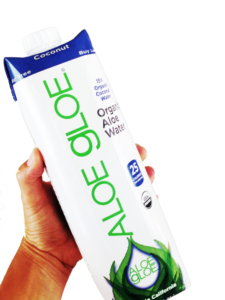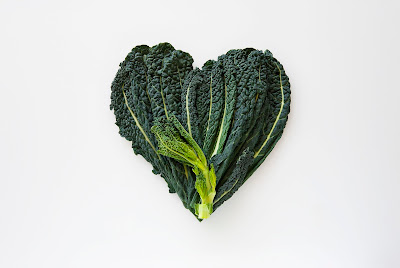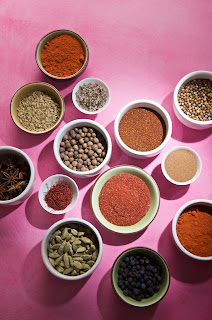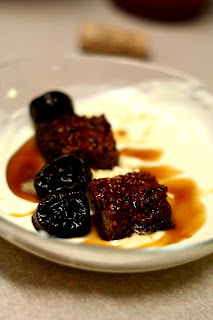In a recent post, I showed you how I make our AFTER SUN LOTION with Aloe vera and essential oils. It’s been fun getting feedback from you guys who have made it! It really DOES work so well!
Topical Aloe application, however, is just the tip of the Aloe vera iceberg in terms of health potential. So I thought it would be fun to stay with the Aloe theme but this time talk about drinking Aloe vera!

I bought this one (of course it includes coconut water which feeds my coconut obsession) but there are other kinds too. I choose to drink this brand – ALOE GLOE – because I trust the company. I think this tastes good and is very refreshing. It’s got a mild taste and is lightly sweetened with organic cane sugar and organic stevia and has only 18 calories per serving. If you don’t like drinking it, you can add it to smoothie or something. It’s packed with vitamins and is clinically proven to improve skin and cardiovascular health (for all you nerds out there, I have more details on the benefits below)
Do you drink it? What’s you favorite? I’d love to know!
Click the link below for 12 pack (15 oz) of Aloe Gloe Organic Aloe Water
Some of you are like me and want to know why in the world we would buy this and then drink it. The answer ‘It’s good for you” isn’t good enough. Tell me why! I don’t like to do things blindly. So if you’re in my camp I included some benefits discovered from research below.
For the others, this is all TMI… and that’s ok too! You guys should definitely just trust me that it’s GOOD FOR YOU, be done reading this post and now click the link above to buy your Aloe Gloe! THE END and thanks for reading!
WHY SUPPLEMENT ALOE VERA
ANTIOXIDANTS >>> Phase II enzymes are known to reduce oxidative stress (… aging process…), and Aloe vera has been shown to stimulate the production of natural Phase II antioxidants. Daily dosing of Aloe vera can stimulate a person’s natural, inherent antioxidant system to help fight oxidative stress. source
INSIDE BEAUTY >>> Thirty healthy female subjects over the age of 45 were orally supplemented with either a low or a high dose (low dose=1,200 mg/day; high dose=3,600 mg/day) of Aloe vera gel for 90 days. After completion of the 90-day period, the KFDA concluded that ingested Aloe vera gel resulted in a significant reduction in facial wrinkles and a significant increase in skin elasticity. There were no adverse events reported. There was also an increase in collagen production and a decrease in collagen-degrading MMP-1 gene expression. source <<< DONE. NUF SAID. I’M IN.
CARDIOVASCULAR BENEFITS >>> Cardiovascular disease is the number-one killer in the United States. Lowering cholesterol is a key prevention in mitigating the risk of heart disease. A number of studies done in the United States and abroad have shown Aloe vera taken as a supplement can help maintain healthy cholesterol levels. One human clinical study showed that the group taking aloe experienced a 10% drop in total cholesterol. This same study showed a drop in LDL and triglyceride levels to near optimum levels.
Cardiovascular health, as well as metabolic syndrome and related issues like diabetes, is also linked to oxidative stress. A recent placebo-controlled human clinical trial showed that the group taking Aloe vera had a significant reduction in risk factors associated with oxidative stress, including C-reactive protein, a marker of oxidative stress and inflammation. In the Aloe vera group, C-reactive protein dropped by 38%, and isoprostanes, compounds formed by the peroxidation of essential fatty acids, dropped by 32%. source
IMMUNE HEALTH >>> Science has shown us ways to enhance our innate immune systems through supplementation, with tests now able to determine if an ingredient is increasing Peripheral Blood Monocyte (PBM) CD56 and the cell-killing capability of natural killer cells.
A study sanctioned by the Korean Food and Drug Administration indicated that the group taking an Aloe vera supplement saw increased PBM CD56 and the cell-killing capability of natural killer cells, indicating immune enhancement. As a result of this study, the KFDA has allowed immune-health claims to be made for products containing Aloe vera. source
There are other benefits being discovered, but I’m sold from just this.
OUR STORY —> aloegloe.com
For us, Aloe Gloe is so much more than just a beverage.
While surfing in Manhattan Beach, co-founder Danny Stepper had an accident that gashed open his forehead. After getting stitches, his doctor prescribed not only applying Aloe Vera to the scar but also recommended drinking it. The problem was he couldn’t find any healthy options that weren’t full of sugar, organic or local. Luckily for Stepper, he and his friends are in the beverage business.
Aloe Gloe is part of L.A. Libations, an emerging beverage incubator that was founded by Stepper, Pat Bolden and Dino Sarti. The three first met while working as merchandisers for Coca-Cola Enterprises and after many successful years in the beverage industry they reunited to create L.A. Libations and in turn their own passion project, Aloe Gloe.
Don’t forget to check out my ALOE VERA AFTER SUN LOTION!

CHEERS TO BETTER HEALTH!













